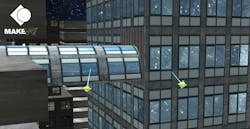The 2014 International CES was chock full of 4K Ultra HD televisions, of course, including curved, glassless 3D, and organic LED (OLED) versions. There were lots of 2-in-1 convertible computers and a plethora of smartphones and tablets as well. Yet a couple of unique items particularly piqued my interest—the $59.95 Ozobot and Sixense’s MakeVR.
The Ozobot is a tiny, autonomous robot that doubles as an intelligent game piece (Fig. 1). About the size of a golf ball (2.5 cm), it has five sensors in a V shape on its bottom that can detect lines. One sensor can detect color. The Ozobot uses these sensors to follow lines and determine their color as it interprets these color sequences as different commands. For example, two blue lines could tell the robot to increase its speed. A multicolor LED on top displays the line and color recognition as well as the commands that the Ozobot rolls over. A micro-USB connector charges the lithium-polymer battery, which provides 40 minutes of continuous operation.
Related Articles
The two controllers map to a pair of 3D cursors that can be used to move, rotate, and scale using gestures that are very natural. Buttons on the controllers allow quick access to frequent actions such as copying and cutting.
This file type includes high resolution graphics and schematics when applicable.
Most designers start using MakeVR for freeform design building with existing objects, from simple cylinders to complex objects. MakeVR also is capable of precise construction including the use of grids and other alignment mechanisms as well as numeric scaling. Object definitions can be exported or uploaded to 3D printing services.
I think that the key to the success of both Ozobot and MakeVR is that they have an elegant design and are easy to use. They also are just the starting point with more to come in the future.



